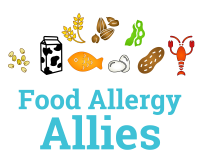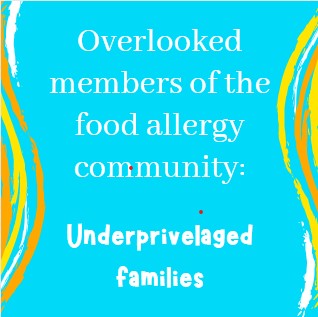The food allergy community is bursting with blogs, organizations, charities, Facebook pages, and more that all aim to provide the insider scoop to dealing with food allergies. From egg free cookie recipes to advice on choosing an allergist, these platforms seem to cover every possible aspect of life with food allergies. Yet, a key group of people is often missing from the narrative: underprivileged families.
Families below the poverty line, which is an annual income of about $27,750 for a family of 4, are typically not the focus of allergy support groups. Instead, the target of a majority of allergy support organizations is a white, middle class to wealthy, elementary school aged, American child. This target arises from both the stereotypical idea that only white American children have food allergies and the general propensity of the media to avoid diversity. Unfortunately, this narrative leaves out many vulnerable members of the food allergy community, including not only people in poverty, but also people in other overlooked groups such as adults and the elderly, people in prison, people of different races and ethnicities, etc. In this article, we will focus on the intersectionality between poverty and food allergies, and we will address future overlooked groups in articles to come!
For people in poverty who have food allergies, they often face more complications than wealthy people with the same food allergies. These complications can be broken down into three categories: purchasing allergen free food, accessing healthcare, and receiving representation and education.
1. Purchasing Allergen Free Food
Low income families live disproportionately in food deserts, which refers to a neighborhood in which fresh or good quality food is hard to find. Consequently, finding allergy friendly food can be more difficult for families in poverty compared to wealthier families.
The estimated overall cost of food allergies in children each year is $24.8 billion
JAMA Pediatrics
Furthermore, allergy friendly food is much more expensive than average food. The estimated overall cost of food allergies in children each year is $24.8 billion, with the cost of special food being the second costliest contributor to this number behind medical expenses. In one UK study, researchers found that certain gluten free foods cost about 159% more than normal foods. Per family, this means that raising a child with food allergies results in 30% more expenses each year compared to a family raising a child without food allergies. These extra costs hit all families with food allergies, but families in poverty get hit the hardest. For families in poverty, 30% more expenses annually places an extreme burden on an already tight budget.
Without enough money to spend on safe foods, children in poverty with food allergies are often left with unsafe food choices offered by free meals at school or independent charity organizations. Reduced or free lunch options at schools have long been a valued resource for children in poverty that many low income families rely on. However, these programs focus on providing fresh, nutritious food rather than allergen safe food. Many schools have become cognizant of nut/peanut allergies, but continue to use milk, eggs, wheat, and soy (among other allergens) heavily in their meals. Similarly, charitable organizations such as food pantries and soup kitchens that provide free meals to homeless or impoverished individuals often focus on high calorie, nutritious, healthy foods rather than allergen friendly foods, with milk, peanut butter, and canned tuna being prized (but also allergen filled) items.
As of 2020, of the 60,000 food pantries and soup kitchens in the United States, only 4 exclusively stock allergen-free foods consistently
Article by Emily Brown, Rajeshree Das, BA, Audrey G. Brewer, Md, MPH, Erin Martinez, MS, Lucy A. Bilaver, PhD, and Ruchi S. Gupta, MD, MPH
So where does this leave impoverished families with one or more food allergies? The high cost of safe foods coupled with the lack of food allergy friendly options at the typical resources for impoverished families leave these families with few options. For those relying on free meals from charitable organizations or schools, side dishes such as plain fruit or canned vegetables often become main dishes. For others, they must choose between paying for utilities, rent, gas, clothes, or allergen safe food. For all, living with food allergies under the poverty line is an immense struggle that is most often overlooked from both the food allergy support community and poverty relief organizations.
2. Accessing Healthcare
Medical costs are the number one expense of raising a child with food allergies. These medical costs, in addition to regular healthcare expenses such as pediatrician, dentist, and optometrist visits, come primarily from ER visits, allergist appointments, and medication copays. According to JAMA Pediatrics, the medical costs of food allergies per child per year is estimated to be $724.
Take an EpiPen for example (epinephrine medication necessary during anaphylaxis): a package of two can cost anywhere between $100 to $700 depending on your brand, coupons, health insurance, pharmacy, etc. This is an example of just one of the many costs of raising a child with food allergies in the US. The extra costs of raising a child with food allergies are even more drastic for families near or below the poverty line.
In one study by Gupta, low income households pay more than twice as much as higher income families for emergency medical care for food allergies. Thus, families raising a child with food allergies are faced with both regular healthcare costs as well as extra allergy-related costs that are even higher than those faced by well off families.
Low income families pay more than twice as much as higher income families for emergency medical care related to food allergies
2016 Study by Gupta (MD, MPH)
Moreover, low income families often face financial barriers to treating food allergies, such as participating in clinical trials, receiving experimental medicine, or visiting the best allergists.
In addition to direct medical expenses, indirect medical expenses can also be incurred due to lost wages from a time period spent attending doctors appointments instead of working. In total, the annual lost labor productivity costs from parents accompanying children with food allergies to medical visits was $773 million according to JAMA Pediatrics.
Overall, recent data suggests that food allergies are an additional financial burden to all families, especially so for low income families. Yet, the struggle of paying the costs of food allergies is rarely discussed amongst the larger food allergy community. Food Allergy Allies aims to change this discussion and bring overlooked communities into the spotlight.
3. Receiving Representation and education
Low income families generally have access to fewer and lower quality social support systems than wealthier families. In regards to food allergies, these support systems can take the form of mentor groups, nutritional/cooking classes, educational literature, informational workshops, medical consultations, and many more. These programs are important because they help unlock the keys needed to live safely and confidently with food allergies. Wealthier families have disproportionately greater access to these programs than low income families who often face socioeconomic obstacles to these support systems.
Due to a lack of educational resources, low income families are less likely to have access to preventative treatments, thus resulting in higher rates of allergic reactions and ER visit. A lack of representation in advocacy groups, awareness campaigns, and fundraising goals casts low income families to the sidelines of the food allergy community. In reality, these individuals are some of the most vulnerable and needy members of the food allergy community.
As demonstrated above, low income families raising children with food allergies experience the “double whammy” of both poverty and food allergies. The expenses of food allergies are exacerbated by poverty, while poverty limits access to opportunities to thrive with food allergies. To top it off, the compounded difficulties of a life with both food allergies and poverty is often overlooked and underdiscussed in the food allergy community. Food Allergy Allies calls upon large advocacy organizations to change their narrative and redistribute their focuses to incorporate some of the most vulnerable members of the food allergy community, and to equip these members with the skills and resources necessary to thrive with food allergies.
Article Sources:
https://aspe.hhs.gov/topics/poverty-economic-mobility/poverty-guidelines
https://www.bbc.com/worklife/article/20190130-why-its-so-expensive-to-eat-with-a-food-allergy
https://www.drugs.com/article/epipen-cost-alternatives.html
https://www.cbsnews.com/news/children-with-food-allergies-from-low-income-homes-may-suffer-more/
https://www.hindawi.com/journals/ja/2014/160363/
https://www.latimes.com/science/sciencenow/la-sci-sn-poor-kids-food-allergies-20160426-story.html
https://jamanetwork.com/journals/jamapediatrics/fullarticle/1738764

